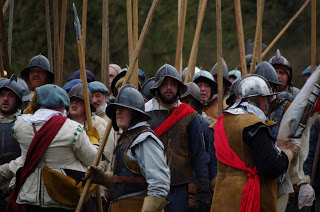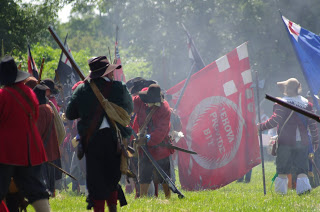Houses of Interest: East Riding
The modern County of East Yorkshire (or East Riding as Yorkshire folk would have it) saw the first symbolic act of the First English Civil war take place here.
Those of you in need of further Yorkshire adventures should check out:
West Yorkshire, South Yorkshire, North Yorkshire , York and Marston Moor and Adwalton Moor.
Let us start with Hull, the symbolic birthplace of the First Civil War, when Sir John Hotham denied King Charles entry to the town and barred the Beverley Gate. As a consequence Hull became a significant target for Charles's ire, being besieged in 1642 and again in 1643.
Hull was Yorkshire's second largest town, only York was bigger. It was a very important port and possessed a large arsenal prior to the outbreak of hostilities (the second largest arsenal in England after London). Sir John Meldrum led raiding sorties out of the town, during the siege, attacking Royalist positions: a lack of coordination of the Royalist forces would see them fall back to Beverley, and the siege withered away.
The 1643 siege was led by the Earl of Newcastle. After the Royalist success at Adwalton Moor, Royalist troops advanced through Yorkshire with an eye on Hull as their prize. These troops did not endear themselves to the local population plundering and pillaging as they went; their actions in Beverley in particular are noteworthy for their savagery.
Lord Fairfax, commanding the Parliamentarian troops in Hull ordered the land around Hull to be flooded, Parliamentarian navy ships commanded the waters of the Humber, Cromwell would cross the Humber with weapons and powder for the Parliamentarians in Hull, and the Eastern Association marched through Lincolnshire to reinforce the garrison. Newcastle attacked the town but made no real progress, the garrison would counterattack a few days later overrunning the Royalist positions, and Newcastle's men would flee to York. Famously two large siege pieces, Gog and Magog, were captured.
The Beverley Gate has been excavated and has a somewhat insignificant plaque for somewhere so important in British history.
Close by is Ye Olde White Harte, parts of the building date from 1550. Local tradition has it as the home of Hotham, the bulk of the building dates from the 1660s. Of course, don't forget the very heavy hand of the Victorians in remodelling the building so that it looked like their interpretation of a C17th pub.
Next stop is the Charterhouse: originally a hospital on the site of a Carthusian monastery, the hospital was given over to the town in the 1550s.
Demolished during the Civil Wars to stop the besieging Royalists from utilising the building, it was rebuilt in 1645 and constantly tweaked and upgraded for the next hundred or so years. there are a number of plaques located on the complex of buildings: the Master's House commemorates the poet Andrew Marvell, whose father was Master of the Charterhouse.
Located on the 1978 building are two plaques: one for the one-time captain of horse fighting at Adwalton Moor, and regicide John Alured; the other for his brother Colonel Matthew Alured who raised a regiment of foot, and would later serve in the New Model Army.
A BBC news article about the Alured plaques states that there is a blue plaque for another Hull regecide, Peregrine Pelham, located somewhere in/on the Hull Truck Theatre Company building, but I could find no sign of it on the outside of the building. Nor is it listed in any blue plaque registers. Maybe one for future installation?
Beverley, located about 9 miles north of Hull is probably best known for it's Minster.
I have flown over Beverley a few times in a Seaking during mountain rescue training exercises at nearby RAF Leconfield: the Minster is even more stunning from the air (although it is a little worrying sitting opposite the open side door when the pilot decides to do a sharp turn).
Inside there is an armorial of either Charles I or Charles II. It is usually listed as that of Charles II, but is monogrammed CR not CR II: Charles II's coat of arms usually has a '2' floating above the helmet, and often has 1660 added somewhere. There is no 'II' or even '2' on the arms, nor any date.
The land adjacent to Minster Yard South is known as the Parks, and was used at various times during the Wars as a military camp.
 |
| The Parks |
The town would be captured and held by Parliament not long after Charles's departure, falling into Royalist hands as Parliament's men withdrew to Hull after their defeat at Adwalton Moor. Newcastle's men would sack the town, literally stripping the town of everything. The Minster remained relatively untouched due to it's connection to the Percy family.
The confluence of the Rivers Ouse and Aire at Airmyn was the location of a Royalist earthwork on Fort Hill. The earthwork was part of the outlying defences of York, this one protecting the river access to the city. Lost beneath farmland and wind turbines the site can be viewed from the footpath on the other side of the river that starts on the High Street.
Wressle Castle was garrisoned by Parliament, the garrison causing considerable damage to the structure during their tenure. The castle saw no action, but would be sleighted in 1648.
The castle is situated on a private estate, and is occasionally open to visitors.
Denied Hull’s munitions Charles needed an alternative
supply, so tasked Queen Henrietta Maria of France to travel to Holland and
France to use the Crown jewels as surety to purchase arms.
Henrietta-Maria, having procured a large quantity of
munitions returned to the east coast protected by seven Dutch ships in February
1643. Her convoy, of ‘seven greater ships …and five for the baggage’ docked at the
harbour in Bridlington. The self-styled Generalissima, is reported as bringing
1000 soldiers, 36 pieces of brass ordinance, 2 pieces of iron ordinance, arms
and ammunition for 12000 men including 2000 cases of pistols, 1000 saddles and
£80000.
 |
| The 'military gallery' at the Baylegate |
Meanwhile, Admiral Batten had been cruising in the north
with four of Parliament's ships with a view to intercepting Queen Henrietta
Maria. Batten received intelligence of her arrival but did not enter
Bridlington Bay until the night after the Dutch vessels had docked. The Queen had
disembarked along with the precious cargo. Batten drew his ships opposite the
Quay, then commenced a heavy bombardment in the hope of hitting the powder
onboard the vessels.
 |
| Bridlington harbour |
Some of the shots penetrated the house in which the Queen
was sheltering and compelled her and her retinue to seek safety beneath the
banks of Gypsey Race stream which empties into the harbour.
She recounted her ordeal in a letter to her husband:
God who protected me at sea, has also done it at land; for this night four of the parliament ships came in without our knowledge, and at 4 o'clock in the morning, we had the alarm, and sent to the harbour to secure our boats of ammunition…But, about an hour after, these four ships began so furious a cannonading, that they made us get out of our beds, and quit the village to them; at least us women, for the soldiers behaved very resolutely in protecting the ammunition… One of these ships did me the favour to flank my house, which fronted the pier, and before I was out of bed the balls whistled over me and you may imagine I did not like the music.
The Queen then goes on to describe how cannonballs rained
over as she fled for cover. It is said she even returned to the house to
retrieve her dog, Mitte.
Everybody forced me out, the balls beating down our houses; so, dressed as I could, I went on foot some distance from the village, and got shelter in a ditch, like those we have seen about Newmarket; but before I could reach it, the balls sung merrily over our heads, and a sergeant was killed 20 paces from me…Under this shelter we remained two hours, the bullets flying over us, and sometimes covering us with earth…As soon as they were withdrawn, I returned to my house, not being willing that they should boast of having driven me away. I can say, with truth, that by land and sea, I have been in some danger, but God has preserved me: and I confide in his goodness, that he will not desert me in other things.
The Queen stayed in Bridlington before processing to York.
Royalist Bridlington would eventually fall to a brief Parliamentarian Siege.
Bridlington Harbour has little changed, other than the modern accoutrements of trawler fishing. Beware of being enticed into the Harbour Museum with its headline advertising of the ‘Escape of Queen Henrietta Maria’ – its display is an A3 laminated panel retelling of the story.
 |
| The Gypsey Race |
The Gypsey Race is now a shadow of its former self, built over, culverted and diverted it is still visible in parts.
 |
| The Priory |
The Queen and munitions moved to the safety of the Old Town;
the munitions being stored in the Priory,
which is conveniently situated next to the remaining gate of the Old Town, the
Baylegate.
 |
| The Baylegate |
It is believed that the Baylegate was at some point
garrisoned.
Postcodes for SatNavs
Ye Olde White Harte HU1 1JG
Charterhouse HU2 8AF
Beverley Minster HU17 0DP
North Bar, Beverley HU17 7AA

















.jfif)





Portraits of Sir Michael Warton's grandson, also Sir Michael (1623-88), Royalist officer, are featured in 'Of Things Collected: NT Ormesby Hall' at https://ofthingstrentnorth345431120.wordpress.com/
ReplyDeleteThanks for the extra local knowledge Phil
DeleteLove the ECW travelogue; these old buildings are inspiring for those of us who like to make terrain. Was a lot of red brick used a lot in norther England?
ReplyDeleteThanks for the kind words Codsticker.
DeleteAs for red brick: I think that may be related to date the building was built rather than locale. It certainly becomes more fashionable to build with brick and stone during Tudor times; it's all about public displays of wealth. Wattle and daub seen as building materials of the poor.
Nice addition to your travelogue collection, I've never had a reason to visit Hull,but at least if I do I will know what to look for!
ReplyDeleteBest Iain
Thanks Iain
Delete